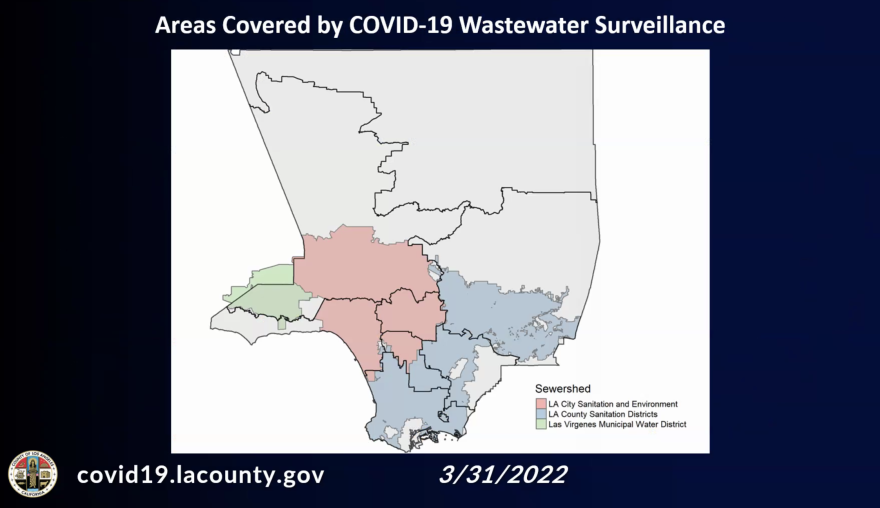With our free press under threat and federal funding for public media gone, your support matters more than ever. Help keep the LAist newsroom strong, become a monthly member or increase your support today.
LA’s Sewers May Tip Us Off To The Next COVID Surge

For months, Los Angeles County has been testing residential sewage to measure community COVID-19 infection levels. The goal is to provide an early alert of rising cases and avoid overwhelming hospital emergency rooms with infected patients.
Two months after the peak of the omicron surge, during which more than 40,000 people tested positive in one day, L.A. County cases have now plateaued at 660 cases daily, while hospitalizations and deaths continue to fall.
“The wastewater results generally are tracking with cases and, at this time, we don't see any significant concentration of SARS CoV-2 in the wastewater for these communities,” said county health director Barbara Ferrer at a press conference Thursday.
Checking wastewater is important because fewer people are visiting testing sites and many may be self-testing for COVID at home and not reporting if they’re positive to the health department.
“The wastewater testing can identify the presence of the SARS CoV-2 virus shed by both symptomatic and asymptomatic people,” Ferrer said. “As more residents are using home test kits, this wastewater analysis could become a very valuable complement to our other surveillance systems.”
Wastewater surveillance is seeing more interest as COVID testing rates wane and the focus of the federal government shifted in March from counting cases to tracking hospitalizations.
At the same time, the Centers for Disease Control and Prevention is tracking the rise of the new omicron subvariant BA.2, now the dominant COVID strain in the nation. Nearly a third of recent L.A. County tests that received advanced genetic sequencing were BA.2. That’s more than double 14.7% from the week prior.
Three wastewater departments collect data in Los Angeles County, though each uses different collection and sampling methods. Sewer systems cover seven of the county’s eight “service areas.” Some areas, such as the Antelope Valley, don’t have a wastewater detection system in place, though Ferrer said her department is working to get systems set up to do sampling there.
The county health department hopes to use the data as a barometer to guide decisions if the viral load climbs, such as reintroducing an indoor mask mandate.
“That’s an indication to us to take a look at protective measures, mitigation measures and make decisions," Ferrer said. "Masking is one, but also making sure we're going back to doing more routine testing at places at higher risk."
Both the state and county health departments dropped the requirement to wear masks indoors in March, though they remain “highly recommended” by health officials.
At LAist, we believe in journalism without censorship and the right of a free press to speak truth to those in power. Our hard-hitting watchdog reporting on local government, climate, and the ongoing housing and homelessness crisis is trustworthy, independent and freely accessible to everyone thanks to the support of readers like you.
But the game has changed: Congress voted to eliminate funding for public media across the country. Here at LAist that means a loss of $1.7 million in our budget every year. We want to assure you that despite growing threats to free press and free speech, LAist will remain a voice you know and trust. Speaking frankly, the amount of reader support we receive will help determine how strong of a newsroom we are going forward to cover the important news in our community.
We’re asking you to stand up for independent reporting that will not be silenced. With more individuals like you supporting this public service, we can continue to provide essential coverage for Southern Californians that you can’t find anywhere else. Become a monthly member today to help sustain this mission.
Thank you for your generous support and belief in the value of independent news.

-
What do stairs have to do with California’s housing crisis? More than you might think, says this Culver City councilmember.
-
Yes, it's controversial, but let me explain.
-
Doctors say administrator directives allow immigration agents to interfere in medical decisions and compromise medical care.
-
The Palisades Fire erupted on Jan. 7 and went on to kill 12 people and destroy more than 6,800 homes and buildings.
-
People moving to Los Angeles are regularly baffled by the region’s refrigerator-less apartments. They’ll soon be a thing of the past.
-
Experts say students shouldn't readily forgo federal aid. But a California-only program may be a good alternative in some cases.







